If you want to start your own business in a growing creative industry, with great earning potential and where no two days are the same, then starting a food truck could be right up your street and we hope this guide will inspire you!
The growth of the “foodie” culture with its food festivals and urban pop-up markets has opened up exciting opportunities for budding entrepreneurs. Private hire of catering and street food vans for corporate or family events has also increased in popularity, as an alternative to bringing in a catering team for a special occasion.
The mobility of a food truck offers the freedom to widen your audience and travel to the places where your customers are likely to be, rather than being tied to a brick-and-mortar restaurant.
Why are food trucks so popular?
Although the history of buying ready-to-eat food from the streets stretches back to ancient times, it is a particularly popular fast-food option nowadays. Street food’s recent rise in popularity has coincided with the economic downturn that started in 2008.
With low overheads, mobile food trucks can offer delicious food faster and far more cheaply than restaurants, widening the appeal of new and exciting cuisines. The rise in street food outlets has seen an expansion of culinary creativity, from vegan options to high-end dishes – further driving consumer demand for the next hot trend.
Street food pitches and pop-ups are usually connected to the local community, helping build a home-grown following as well as on social media. It also offers a more flexible and relaxed way of enjoying delicious food with friends compared to dine-in restaurants. Snapping and sharing photos of dishes often starts spreading the word and trending on social media, creating a frenzy for the latest “must try” culinary experience!

If you can create an eye-catching vehicle with beautifully made dishes that are Insta-worthy – you’re sure to start noticing people coming from all-around to try your dishes.
During the Covid-19 pandemic, the street food sector experienced an unforeseen surge in demand as restaurants were forced to close during lockdown. It’s expected to continue as the population enjoys spending time safely outside with friends and family. This guide takes you through everything you need to consider when starting your own street food business, to increase your chances of success.
If you're thinking of starting a food truck, can you answer “Yes” to these five questions?
If you can't answer “yes” yet to the above five questions, don't worry! We'll run you through food truck best practice and tips to ensure you feel prepared before embarking on your food truck journey. Have a read of our ultimate guide below and let's review these questions later to see if you're ready to say "yes" to getting started with street food! |
What are the challenges of running a food truck?
It can be all too easy to fall in love with a vehicle, or street food idea without thinking the whole project through – or even thinking of it as a business! Here are the top challenges that often crop up when starting a food truck business.
-
Sourcing the right vehicle and paying for it. Finding the perfect vehicle can take time, and once you have found it, there is the cost of converting it into a food truck and giving it a makeover to establish your brand. All of this has to be budgeted for.
-
Getting a handle on food truck regulations. This can seem like a minefield and cannot be avoided, but there is plenty of help at hand to guide you through safely.
-
Fitting the vehicle. As well as the finance, you will need the expertise to get your vehicle equipped to go on the road. From ovens to running water and power options, it’s best to find a mechanic or company that specialises in street food trucks.
-
Finding events and locations to set up your food truck. There are countless possibilities when it comes to finding the right spot to park up your vehicle, but we have tips to help get you started.
-
Food truck marketing strategies. How will you launch your business into the increasingly competitive world of street food? You'll need to make your food truck stand out from the crowd - and we have some suggestions to inspire you.
8 Steps to Starting a Food Truck Business
Step 1: Developing your idea and creating a business plan
Having a vision
Before you explore how to start a street food business, you need to develop your idea. There’s no point purchasing a food truck until you have a clear picture of what you want to achieve and how. Once you have a clear vision of your business, you're ready to get into the starting blocks and create a business plan.
If you don’t already have any idea of what food style to serve from your food truck, try doing some market research:
- Go to food markets, pop-ups and events to check out what the food trucks are serving.
- Which stalls are the most popular?
- Is there a gap in the market at the location or events you want to operate from?
- What will make you stand out from the crowd?
You may be inspired by a favourite family recipe that you want to share with the world, or a wonderful dish you discovered on travels abroad. If so, will it be easy to cook and serve from a food truck? Is it an economical recipe, or does it require expensive ingredients that will eat into your profit?
For more information check out how to write a food truck business plan that gets investment.

Be realistic - how much does a food truck cost?
It typically costs £5,000-£20,000 to purchase your initial vehicle, and another £20,000-£30,000 to convert it. If you are planning to restore a vintage vehicle for street food, add another £15,000-£20,000.
This might sound like a lot of money, but it isn't hard to secure loans with affordable repayment schemes for business, something we will cover in the next section.
If you have little or no capital or access to finance you could start with a stall, then invest in a food truck as your business becomes profitable. A smaller food truck serving cold food or drinks, such as cider or champagne, will be easier and cheaper to convert if you want to start your business with a smaller budget.
Check out our food truck price guide for more information on cost. You will learn the typical price range of street food vehicle projects and the individual price ranges for the individual components that go into the final product.
Test your food and finalise your recipes
Trying out your food on friends and family will help to gauge its popularity and decide what equipment you will need for your food truck that can be added into your business plan.
Who will be your customers?
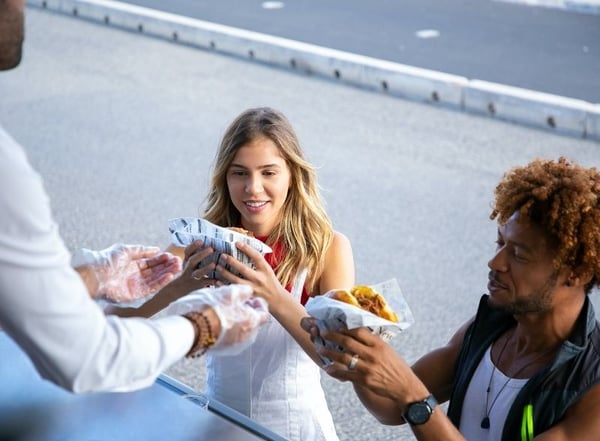
From the classic ice cream van, to a sophisticated sushi bar, the type of food truck you launch will determine who your customers will be and where you will find them. Will you be serving a specialist dish that will excite foodies at a food festival, or the classic hamburgers and hot dogs for people who just want something filling and cheap “on the go”?
Your market research will help you decide who you want to target, and whether you will have a permanent pitch where there is plenty of footfall, or will reserve pitches at different events every week. Alternatively, you could get yourself known for providing fabulous food at special events, such as birthday parties, weddings and office parties.
Try before you buy
If you want to give your idea a trial before laying out for your own food truck, you could hire a vehicle for a few weeks, to test the water. If the trial is a success, you can then take the plunge and invest in your very own vehicle.
There is an impressive selection of vintage and unusual vehicles available to convert and hire for a few months, check them out on Promohire.
Creating your business plan
Creating a comprehensive business plan before you spend money on a food truck is essential in order to check out the feasibility of your business idea. By writing down every aspect of your business proposal, including the start-up and running costs, you can calculate how much investment is required and how much turnover you need to start making a return.
A business plan will help you clarify your business idea and the type of vehicle you will need and create a roadmap to steer you along the way. You will also need to have a business plan to apply for any finance or loans.
Start planning your finances with our free start up costs and profit and loss templates. Download now!
Step 2 – How to fund a street food business
Whilst it might take a considerable amount of money, with a solid business plan in place it won't be difficult to secure a loan to get your project off the ground.
Check out our food truck financing guide for more information. You will learn how to finance a food truck, what your financing options are, and how to keep your costs down.
While it might seem logical to invest your savings rather than taking out a loan, the best option is to keep any capital you have saved and apply for finance, for example, a three-year lease.
The lease should be viewed as an investment in your business, not a debt, as the monthly repayments can be incorporated into your business plan, freeing up your capital to spend on the remaining start-up and running expenses, until the business starts to cover its costs.
With all of this information laid out, you can then calculate if you will be able to make a profit at the end of the three years.
Calculating your costs - what do you need to plan for?These are the costs of a street food business, that you need to calculate as accurately as possible, ready for putting into your business plan.
|
To help you to succeed with your Food Truck business, read our article explaining The 7 Top Reasons Why Food Trucks Fail.
Step 3 – Food truck regulations and permits
An understanding of the regulations and permits required to trade with a food truck, are an essential part of running a street food business. The Nationwide Caterers Association (“NCASS”) offers advice and guidance - as well as savings and discounts on the supplies you will need. Visit their website for more information about all the red tape involved in running a food truck, including:
- Street Trade Licensing
- Gas Safety
- Temporary Event Notices
- Alcohol Licenses
- Health and Safety
- Due Diligence
- Vehicle, Towing and Driver Licensing
- Noise Pollution
- Data Protection
- Primary Authority
- Employment Law
- Electrical Safety
- Allergen Legislation
- Fire Precautions/Extinguishers law
- Food Hygiene Rating Scheme
- Covid-19 Compliance
Check out our blog to delve deeper into food truck regulations.
Step 4 – Buying a food truck
As your biggest purchase and the centrepiece of your street food business, you need to ensure you find the right vehicle, and then maintain it properly. Below are some of the common questions that people ask when choosing a truck or trailer:
What needs to be considered when purchasing a food truck?
-
Size - The type of street food you will be selling will determine the minimum size food to purchase in order to accommodate all the equipment you will need. So the quickest way to determine the size vehicle you need is to create a floor plan. As mentioned earlier, the equipment required to serve any hot food or drinks will take up more space, so this is a major factor to consider. More details about what to include in your floor plan can be found in “How do I create a food truck design plan?” below.
-
Cost – as mentioned in Step 2, this can range hugely in price depending on the size of vehicle and whether or not it is already converted to use as a food truck. The type of vehicle also affects cost due to its shape and availability in the market. For example, a simple square truck or trailer costs less to wrap and kit out than a more engaging, curved shape, like an Airstream, as fitting the interiors will be more challenging and time consuming. VW Camper vans with their specious interiors and 60’s vibe are a more affordable option, especially if they are already converted. However, a rarer vintage vehicle, like a Citroen H van, will cost more as they are more difficult to find, especially reliable ones!
-
Type of food – the type of food you will be serving also has a bearing on the best sort of vehicle to use. For example, it is easy to opt for the classic ice cream van if you will be selling ice cream, but what is best for pizzas, burgers or sushi? The type of cooking and storage facilities you need all have to be taken into account, so do some research into which food trucks work best for your cuisine.
-
Brand – what sort of vehicle will suit your brand? Something modern? Sophisticated? Or retro?
-
Storage facilities – Where will you be storing your vehicle? Will you be able to store it under cover? Consider how much space your vehicle will occupy and how you will keep it secure. You won’t want to keep it on the street because it doesn’t fit in your garage.
-
Mobility – will you be travelling far and wide with your food truck, or keeping it in one place? The amount of mileage you will be travelling is another factor to be taken into consideration. A sturdy new vehicle will be more reliable and economical to run than a rare vintage model that looks fantastic, but may let you down on a long road trip. You also need to consider size and manoeuvrability if you will be parking at multiple locations.
Not sure which type of vehicle is right for you? Check out these fabulous vehicle options that make the best food trucks.
How do I find a food truck?
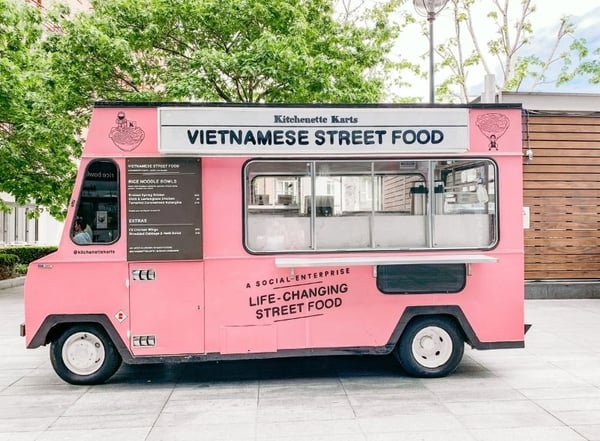
The best place to source vehicles for food truck conversions is to search online – eBay is a great start to search for second-hand trucks and trailers. You can purchase a vehicle and convert it into a food truck yourself, or pay an expert with the experience and skills to do it for you.
Check out our blog "The complete guide to buying a food truck" for more helpful information.
TOP TIP:If you choose to outsource it to a company that specialises in fitting out and wrapping food trucks, they may also be able to assist you with sourcing a suitable vehicle. |
How much food needs to be stored on board?
The amount of storage space you will need for food will depend on:
-
Demand - For example, if you will be selling burgers, how many burgers do you calculate you will need to take to markets and events? You don’t want to run out and you also want to keep waste to a minimum, so do as much research as you can beforehand. Maybe do a trial run at home beforehand to figure out how many burgers you can cook and serve in one hour to help you work out how many burgers you could sell in a day.
-
Type of food - if your main food that you will be selling is fresh chips, then you need a large space to keep bulky sacks of potatoes or big containers of ready-prepared chips. Pizzas will need somewhere to keep large quantities of pizza dough. Dishes where the main staple is rice, will require less storage space, as uncooked rice takes up much less space than a bag of potatoes.
-
Shelf-life – Safe food storage and compliance with health and safety regulations is very important. Fresh, perishable foods can only be on the food truck while you’re open and serving customers. However, foods with a longer shelf life, like dried and frozen foods, can remain on the food truck, ready for cooking next time.
How do I create a food truck design plan?
As mentioned earlier, transforming a simple square vehicle such as a Ford Transit into a food truck will be cheaper and easier than converting a vehicle with a more unique shape. Once you have your vehicle, here is some guidance on how to design a food truck kitchen:
-
Create a floor plan – you will already have the version you created before purchasing your food truck, but once you have the vehicle and know its exact dimensions, you can create a much more accurate and detailed version of the floor plan.
-
Storage - Include cupboards, fridges and freezers. Remember to include space for your cooking equipment and any disposable plates, napkins and cutlery you will be using.
-
Preparation You will need a preparation and cooking area and this depends on the type of food you are serving. Do you need a pizza oven/deep fat fryer or somewhere to simply sprinkle sugar on strawberries?
-
Staff requirements - Ensure there will be enough room to move around if two or three people will be working on the truck.
-
Serving area - Think of the size and location of the space you will be serving the food from.
-
Washing facilities – bear in mind how much space you will need for washing up food preparation and serving items, as well as hand washing.
-
Extractor fan – this is required if you will be using a griddle or fryer.
-
Flooring – an easy-to-clean, non-slip floor is a must
-
Power – how will you be powering your cooking facilities? Will you be using solar energy, electric batteries or petrol generators? The amount of voltage your cooking requires, emissions guidelines and regulations and insurance rates are all factors to consider when deciding what fuel to use on your food truck.
-
Ventilation and fire exits – both essential safety factors to include in your design.
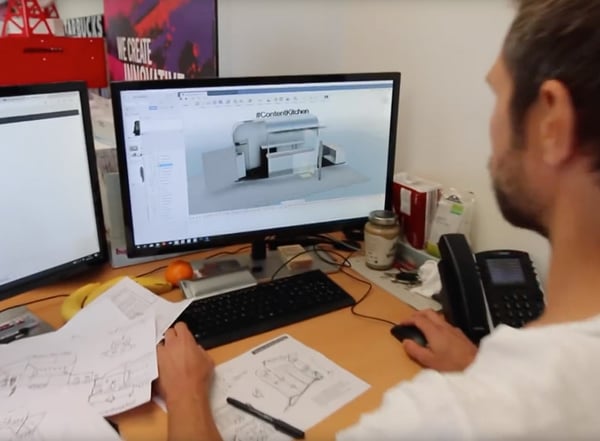
Assuming you don’t already have experience of how to build a food truck, it is advisable to outsource the design to ensure you get the best results and adhere to health and safety requirements.
Looking for more tips to design a food truck kitchen? We've got your back, check these out...!
How do I brand my food truck?
Your street food branding that your vehicle wrap will display is what people will first see before they taste your food, and it could make the difference between whether or not they decide to try what’s on offer, so it is important to get it right. Your brand should:
-
Look professional – an engaging visual will enhance trust in what you are serving
-
Reflect your personality – it’s all about wearing your heart on your sleeve. Decide what values and passions you want to convey - for example, do you want it to be fun, or sophisticated?
-
Showcase your cuisine style – what makes your dishes unique? Try and make your brand authentic.
|
If you need help, working with professionals can help you create a clear brand and logo design you're happy with. In addition to a branded vehicle wrap, the design can be used on your website and display items, such as promotional flags, A-Boards and parasols to complement your food truck. |
Maintaining a Food Truck
It should go without saying that you will need to keep your food truck in tip-top condition and looking fabulous at all times. Missing events due to your vehicle breaking down will be costly. Routine maintenance, like checking tyre pressure, oil and water you can do yourself, but your vehicle must also be serviced regularly. It may help to create a spreadsheet to keep tabs on the following:
-
Insurance renewal date
-
Road Tax, MOT and service dates and garage details
-
Vehicle wrap supplier details
-
Catering equipment service and guarantee details
Check out the pros and cons of purchasing a food truck vs a food trailer.
Step 5 - Planning a food truck menu
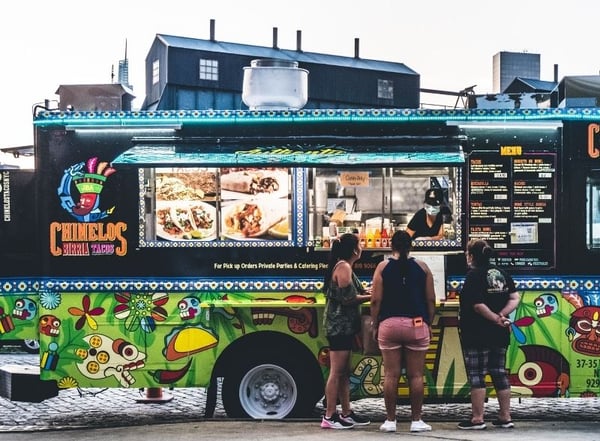
Having decided on the type of food you will be serving, and the vehicle, the next thing to think about is your menu. The main things to consider when planning your menu will be:
Number of menu options
Create a small selection of dishes that share a lot of the same ingredients as you will have limited storage space.
Your menu needs to be clearly visible to attract customersDisplaying your menu attractively on the outside of your food truck will be more eye-catching than a menu inside the vehicle or on the counter-top. Some of your signature dishes could be incorporated into your vehicle wrap, to draw attention to your food truck. Your menu could also be displayed on an A-board in front of your food truck to help catch the attention of passers-by. |
Speed of cooking
Your customers will not want to wait long to be served their food so make sure your menu options are quick to cook.
Allergens
If your food contains allergens such as nuts or dairy, this needs to be clearly indicated on the menu. The NCASS Allergen Hub has helpful information about allergen guidance and legislation.
Pricing
To decide how much to charge per portion, divide the average number of portions you expect to sell between your costs. For example, if your costs per month add up to £10,000 and you estimate you will sell 10,000 portions of food, you will need to charge £1 per portion to cover your costs. Anything over £1 will give you a profit, but if you fall short of selling 10,000 portions, you will make a loss.
Try and make sure you have some money put by as a cushion in the early days, as your sales estimates may not be correct. You may find you have to either try and sell more portions, or put up your prices if you are making a loss and cannot reduce your costs.
Ways to save money in a street food business
|
For more inspiration, check out our Definitive Guide to the Best Street Food Menu Ideas.
Step 6 – Food truck business ideas
Deciding where to run your food truck business will be fundamental to the success of your venture. This should form part of your initial market research, with the following to bear in mind:
-
Where did you visualise trading when you initially decided to start a food truck? Was it at sporting events, food festivals or your own local market?
-
Do you want to travel around the country, or stay local?
-
Who will your customers be and where are you likely to find them?
-
Do you want to be near your competition? Or would you rather be the only kid on the block that serves your type of menu?
-
Will you have permission to park? You may think that a busy seaside resort will be the best place to locate your food truck, but the local authority may not permit it.
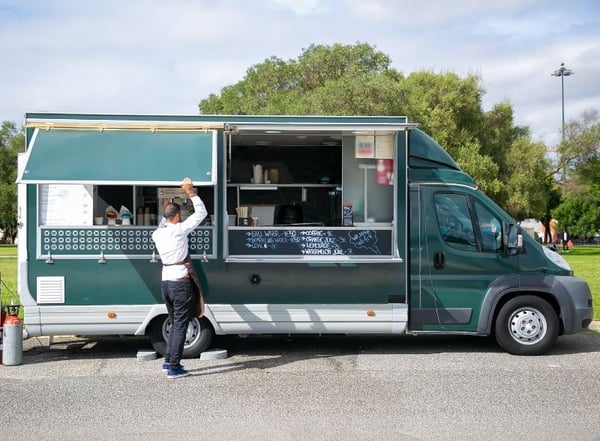
Knowing the answers to the above questions should help you to narrow it down, and there are online directories available for you to book early.
If you are going to be a “roving” food truck, travelling to different locations to attend events, you can keep track by creating a spreadsheet with columns for the following details:
-
Upcoming events to book/attend - be sure to book pitches well in advance
-
Event details – for example, Exhibition/Agricultural Fair/Music Festival/Sporting Event?
-
Contact details for the organisers of the event
-
Anticipated footfall
-
Event costs and expected profit
-
Staffing arrangements for your food truck, if applicable
-
Route and travel time to event
-
Parking availability and cost, if a pitch cannot be booked in advance
You could also use the spreadsheet to give the event a success rating afterwards, for future reference.
We have lots of suggestions to help you - check out "The entrepreneurs guide to food truck business ideas" to get you started.
Step 7 - Attracting customers to your food truck
You could launch the best street food truck in the world but if no-one knows about it, you won’t be a success. Simply relying on passing trade is not enough – you need to have a “following”. You have created an exciting brand and menu, invested in a fabulous vehicle and wrap, and now you want people to fall in love with what you do and seek you out.
Here are some marketing ideas to help you bang your drum and let people know you have arrived on the scene.
-
Create a website
Create a strong “story” for your brand around what inspired you to launch your food truck. You can then incorporate a QR code into your vehicle wrap that will take people to your website where they can find out more about you.
-
Establish yourself on social media
Food trucks with a strong social media presence usually do best in such a competitive environment. Create anticipation before you launch by documenting your food truck journey. Upload photos and videos of your food and food truck onto Instagram and Facebook to get people talking. Once you’ve launched, reshare posts from your followers to increase your audience and attract new customers. If your budget permits, engage a professional photographer to take photos that do real justice to your hard work.
-
Encourage people to sign up for your email newsletters
Send out bulletins from time to time with news of where you will be and exciting photographs from events to maintain contact with your customers.
-
Offer coupons and discounts
You could offer a free dish to new email newsletter subscribers.
-
Make your launch special
Make it an occasion and see if you can entice food bloggers and influencers along to review your food with free food sampling.
-
Listen to feedback
Always acknowledge feedback that you receive in person or via social media, whether it be good or bad. If someone posts a negative comment, don’t ignore it. Respond politely, taking their comment seriously to smooth things over, however unfair their feedback may seem. Handled correctly, their negative comment can still reflect positively on your business and will not put off customers.
-
Reward loyal customers
Always thank people for offering positive feedback about the experience of visiting your food truck. You could ask them to leave a review on Google/Trustpilot/JustEat/Deliveroo or for a testimony for you to feature on your website. You may also want to consider running a loyalty scheme for regular customers, to show them how much their custom is appreciated.
Step 8 - Food truck or restaurant? You can have both!
Restaurants have had a tough time of things during the Covid-19 pandemic. One way to boost your revenue and reach new customers is to launch a mobile version of your restaurant. This could work if you can say “yes” to the following:
-
Do you have lunchtimes or evenings when your restaurant is quiet? If your restaurant is doing a roaring trade all day, every day, then you probably don’t have the time or spare manpower to run a separate food truck.
-
Do you sell the type of food that would work with a food truck, e.g. Oriental noodle dishes, Spanish paella, Mexican tacos, Indian curries etc?
-
Do you have a source of finance to launch a food truck?
-
Do you have staff who could help run the food truck?
-
Do you know where you could set up your food truck? Maybe you have customers who say they would visit your restaurant more often if you were closer to where they live, who would welcome your presence in their neighbourhood.
Let's circle back...
We hope this guide has given you “food for thought”, how do you feel about answering these questions now?
|
We hope this guide has been helpful! If you decide to go ahead with launching a food truck we wish you lots of luck with your new venture.
Step 9 - Bringing your food truck to life
It's one thing to create a menu, write a business plan, buy a vehicle, and source equipment, it's quite another to combine those elements into a day 1 ready for action business.
Actually remodelling and even restoring a vehicle for a food truck business is no easy task and does require specialist skills, time and patience, something you may not have if you've already secured a time sensitive loan to secure your new business assets.
Most Street food entrepreneurs opt to use multiple smaller companies to outfit their vehicles or use a dedicated service that can handle the whole job in-house. This is something we offer at Raccoon; custom streetfood vehicles, business ready, from day one.
We provide a variety of services to help get you up and running as quickly and as efficiently as possible, but we recommend you read all the free resources we offer on this site first, to inform your enquiry.
That's exactly what recent client Susan Curry did. Check out Susan's story to learn how, with the help of Racoon, she got Susan's Crusin Cusine off the ground and onto the road!
To help you put together an informed enquiry, we've created a dedicated Streetfood enquiry checklist. The checklist contains the information we would like to see from you and the enquiry form itself, at the bottom of the page.
Once you fill out the form with the required information, a member of our team will get back to you within 24 hours to pick up the conversation and arrange a call to see how we can best help you.
If you are ready to take things to the next level, then navigate to the checklist, make sure you have all the information required, and fill out the form, we will be more than happy to help!
